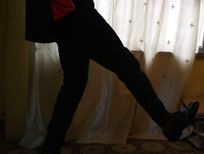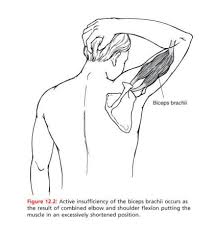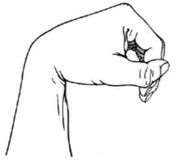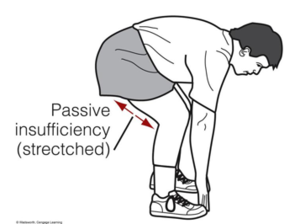Active and Passive Insufficiency: Difference between revisions
No edit summary |
mNo edit summary |
||
| Line 9: | Line 9: | ||
== Active Insufficiency == | == Active Insufficiency == | ||
When a prime mover (agonist) becomes shortened to the point that it cannot generate or maintain active tension, active insufficiency is reached. Active insufficiency occurs when a multi-joint muscle shortens over both joints simultaneously, hence, creates so much slack, that muscle tension is almost completely lost<ref name=":0">1. Rogers M, Rogers M. Understanding Active and Passive Insufficiency [Internet]. National Federation of Professional Trainers. 2020 [cited 17 September 2020]. Available from: https://www.nfpt.com/blog/understanding-active-and-passive-insufficiency</ref>. | When a prime mover (agonist) becomes shortened to the point that it cannot generate or maintain active tension, active insufficiency is reached. Active insufficiency occurs when a multi-joint muscle shortens over both joints simultaneously, hence, creates so much slack, that muscle tension is almost completely lost<ref name=":0">1. Rogers M, Rogers M. Understanding Active and Passive Insufficiency [Internet]. National Federation of Professional Trainers. 2020 [cited 17 September 2020]. Available from: https://www.nfpt.com/blog/understanding-active-and-passive-insufficiency</ref>. | ||
* The hip cannot be fully flexed, and the knee fully extended simultaneously, because of the shortening of the | * The hip cannot be fully flexed, and the knee fully extended simultaneously, because of the shortening of the rectus femoris. | ||
[[File:Hip flexion 1.jpg|thumb|alt=Hip flexion|237x237px|Hip flexion without knee extension|center]] | [[File:Hip flexion 1.jpg|thumb|alt=Hip flexion|237x237px|Hip flexion without knee extension|center]] | ||
| Line 15: | Line 15: | ||
* Maximal shoulder flexion cannot be achieved simultaneously with maximal elbow flexion due to the shortening of the Biceps brachii. | * Maximal shoulder flexion cannot be achieved simultaneously with maximal elbow flexion due to the shortening of the Biceps brachii. | ||
*[[File:Active insufficiency of biceps brachii.jpg|center|thumb]]{{#ev:youtube|FT7OABz8I5k}} | *[[File:Active insufficiency of biceps brachii.jpg|center|thumb]]{{#ev:youtube|FT7OABz8I5k}}<ref>9. Active Insufficiency [Internet]. 2020 [cited 19 September 2020]. Available from: https://youtu.be/FT7OABz8I5k</ref> | ||
<ref>8. Active and Passive Insufficiency [Internet]. 2020 [cited 19 September 2020]. Available from: https://youtu.be/vCEYDZvox2s</ref> | |||
== Passive Insufficiency == | == Passive Insufficiency == | ||
Revision as of 23:33, 19 September 2020
Original Editor - Innocent Abugu
Top Contributors - Innocent Abugu, Lucinda hampton, Kim Jackson and Alicia Fernandes
Introduction[edit | edit source]
The amount of force or tension generated by a multi-joint muscle (muscle that crosses two or more joints) diminishes as the muscle moves the joints simultaneously. Muscle insufficiency is a condition in which a muscle is unable to exert its normal force and bring about movement of the part to which it is attached.[1] It can either be passive or active.
Active Insufficiency[edit | edit source]
When a prime mover (agonist) becomes shortened to the point that it cannot generate or maintain active tension, active insufficiency is reached. Active insufficiency occurs when a multi-joint muscle shortens over both joints simultaneously, hence, creates so much slack, that muscle tension is almost completely lost[2].
- The hip cannot be fully flexed, and the knee fully extended simultaneously, because of the shortening of the rectus femoris.
- Maximal shoulder flexion cannot be achieved simultaneously with maximal elbow flexion due to the shortening of the Biceps brachii.
- [3]
Passive Insufficiency[edit | edit source]
When the opposing muscle (antagonist) is stretched to a point where it can no longer lengthen and allow further movement, passive insufficiency is reached. Passive insufficiency occurs when a multi-joint muscle is lengthened to its fullest extent at both joints, but also preventing the full range of motion of each joint it crosses.[2]
- Full finger flexion cannot be achieved if wrist flexion occurs simultaneously.
- Maximal hip flexion and maximal knee extension are limited by the lengthening of the Hamstrings.
References[edit | edit source]
- ↑ 2. muscular insufficiency [Internet]. TheFreeDictionary.com. 2020 [cited 17 September 2020]. Available from: https://medical-dictionary.thefreedictionary.com/muscular+insufficiency
- ↑ 2.0 2.1 1. Rogers M, Rogers M. Understanding Active and Passive Insufficiency [Internet]. National Federation of Professional Trainers. 2020 [cited 17 September 2020]. Available from: https://www.nfpt.com/blog/understanding-active-and-passive-insufficiency
- ↑ 9. Active Insufficiency [Internet]. 2020 [cited 19 September 2020]. Available from: https://youtu.be/FT7OABz8I5k
- ↑ 8. Active and Passive Insufficiency [Internet]. 2020 [cited 19 September 2020]. Available from: https://youtu.be/vCEYDZvox2s











